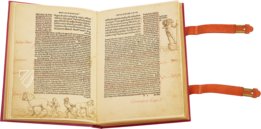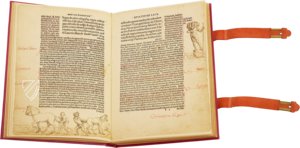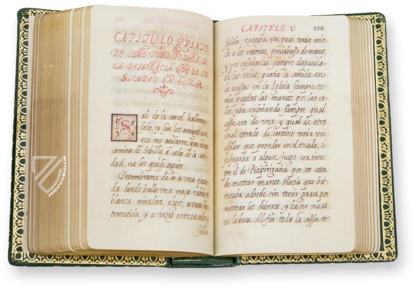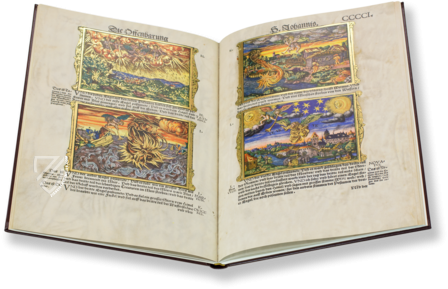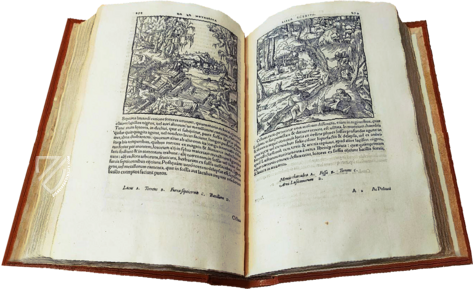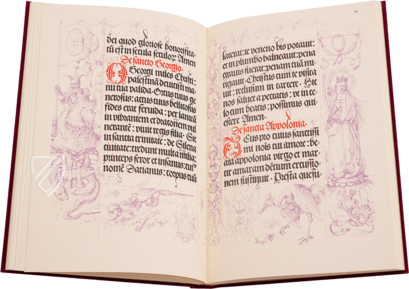Erasmi Roterodami Encomium Moriae
(under 1,000€)
Erasmi Roterodami Encomium Moriae or In Praise of Folly by Erasmus of Rotterdam is a Latin essay written in 1509 and first printed in June 1511 that is regarded as one of the most significant works of the Renaissance and played an important role in the early stages of the Protestant Reformation. It is a work of satire attacking superstitions, the Catholic Church, and various European traditions. Originally written within a week’s time, Erasmus edited and appended his work while staying with Sir Thomas More, another noteworthy humanist, at his home in London. It begins with an encomium, a speech in praise of someone or something, in which Folly praises himself before moving on to a series of orations praising things like self-deception and madness before examining the superstitious abuses of Catholic doctrine. Its text is full of double or even triple meanings and the title can also be read as “In Praise of More”, the close friend of Erasmus with whom he shared a love of dry humor. The work enjoyed tremendous success across Europe, was translated in various languages, and even Pope Leo X is reported to have been amused by it. Originating ca. 1515, the Basel Codex was Erasmus' personal copy, which he had illustrated by Hans Holbein the Younger and his brother Ambrosius with pen and ink drawings in the margins.
Erasmi Roterodami Encomium Moriae
In Praise of Folly by Erasmus of Rotterdam (1466–1536) was first published under a double title: the Latinized Greek Moriae encomium and the Latin Laus stultitiae. It is a satire inspired by De triumpho stultitiae or The Triumph of Stupidity, which was written between 1480 and 1490 by Italian humanist Faustino Perisauli (1450–1523). Both works are highly critical of the more ridiculous religious, superstitious, and societal conventions of the period. As such, it was an important and influential work during the early days of the Protestant Reformation. Erasmus himself was astonished and even sometimes dismayed by the success of his work and feared reprisals, but even Pope Leo X (1475–1521) is reported to have been amused by it. Translated into numerous languages, it became a popular text for teaching rhetoric, which enjoyed a revival during the 16th century, and influenced the art of adoxography, an elegant and refined style of writing addressing trivial or base subjects, which was a common exercise in Elizabethan grammar schools.
A Renaissance Satire
The opening encomium of is modeled on the 2nd century Greek satirist Lucian, whose work had recently been translated by Erasmus and his friend Sir Thomas More (1478–1535). It is followed by a series of orations that are darker in tone as Folly examines the superstition, corruption, and doctrinal abuses of the Catholic Church and the idiocy of pedants – those who make an ostentatious and arrogant show of learning. Despite his piety and faithfulness to the Church, Erasmus had a profound feeling of disappointment after returning from Rome, where he had turned down offers of advancement in the corrupt and bloated curia. The work is filled with allusions to classical antiquity, e.g. Folly is presented as the divine offspring of Plutus, the goddess of wealth, and Youth, a nymph. Folly is nursed by his fellow nymphs Inebriation and Ignorance. Her companions are Pleasure, Dementia, Wantonness, Intemperance, and Heavy Sleep. Unsurprisingly, Folly never stops praising herself and states that in the world "you'll find nothing frolic or fortunate that it owes not to me." In Praise of Folly ends with a Christian lesson in humility: "No Man is wise at all Times, or is without his blind Side."
Codicology
- Alternative Titles
- Erasmus von Rotterdam - Lob der Torheit
- Size / Format
- 168 pages / 22.5 × 16.5 cm
- Origin
- Switzerland
- Date
- Ca. 1515–1516
- Epochs
- Style
- Language
- Illustrations
- 83 pen and ink drawings by Hans Holbein the Younger
- Content
- In Praise of Folly
- Artist / School
- Erasmus of Rotterdam (1466–1536) (author)
Ambrosius Holbein (ca. 1494 – ca. 1519) (illustrator)
Hans Holbein the Younger (ca. 1497–1543) (illustrator)
Johann Froben (ca. 1460–1527) (publisher) - Previous Owners
- Oswald Myconius (1488–1552)
Erasmi Roterodami Encomium Moriae
Voluptas venandi - The pleasures of the Hunt
Erasmus of Rotterdam's remarks on the pleasures of the hunt, as he derisively described the courtly hunting culture, are accompanied by a dynamic pen and ink drawing in the bas-de-page. It shows a vast landscape in which a hunt with dogs for a stag is taking place - a type of hunting that was considered one of the noblest and was reserved for the nobility due to the great expense involved. Two dog handlers rush after the hunting hounds, which drive the stag into a net trap on the left-hand side, behind which another hunter is lurking. Such a spectacle was observed rather than performed by the aristocratic participants.
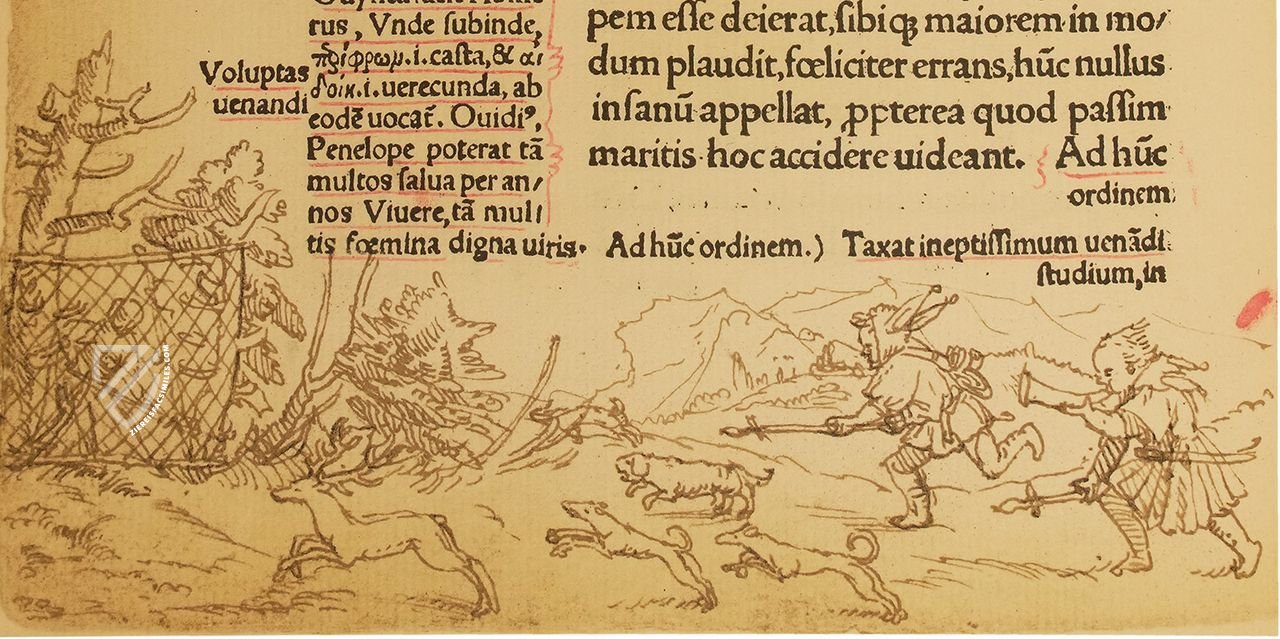
Erasmi Roterodami Encomium Moriae
Mathematics and Theology
Erasmus of Rotterdam also had ironic words for the sciences, thus practicing self-criticism in a way, as he himself was a scholar of various disciplines, such as theology, philosophy and philology. This page is about mathematics and theology, as the reading aids in the margin show. The two-part text, consisting of the main part printed in larger letters and the customized commentary, has the typical layout of an academic work.
In addition to the handwritten annotations, there are two exquisite pen and ink drawings in the margins. They depict the personifications of mathematics and theology. The first holds a globe and an armillary sphere in his hands and is also attributed with a reckoning board, a pair of compasses and a harp. The latter, dressed in a cardinal's robe, sits at a writing desk, which is also a repository for liturgical objects, as a half-opened door reveals.
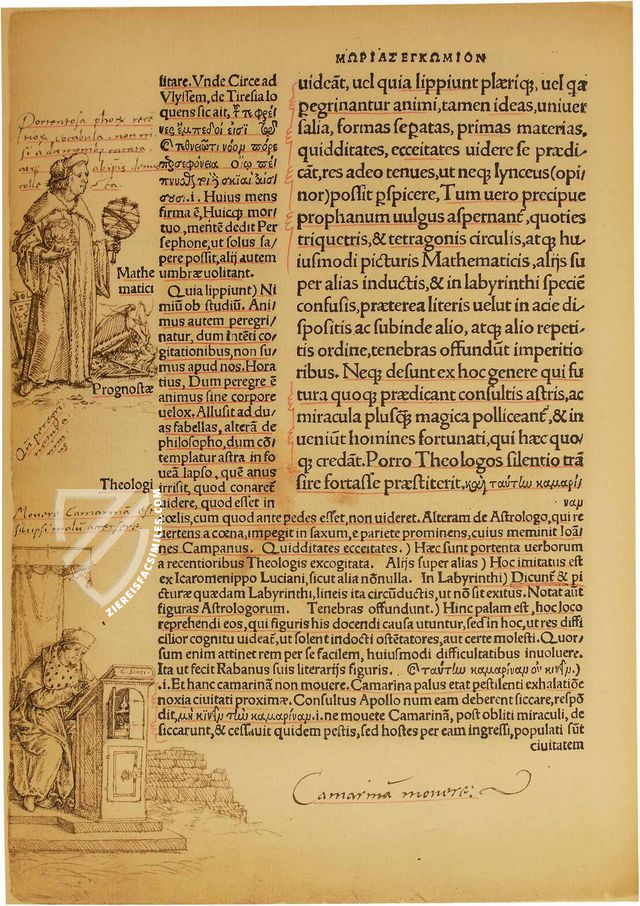
#1 Erasmi Roterodami Encomium moriae
Languages: English, German
(under 1,000€)
- Treatises / Secular Books
- Apocalypses / Beatus
- Astronomy / Astrology
- Bestiaries
- Bibles / Gospels
- Chronicles / History / Law
- Geography / Maps
- Saints' Lives
- Islam / Oriental
- Judaism / Hebrew
- Single Leaf Collections
- Leonardo da Vinci
- Literature / Poetry
- Liturgical Manuscripts
- Medicine / Botany / Alchemy
- Music
- Mythology / Prophecies
- Psalters
- Other Religious Books
- Games / Hunting
- Private Devotion Books
- Other Genres
- Afghanistan
- Armenia
- Austria
- Belgium
- Colombia
- Croatia
- Cyprus
- Czech Republic
- Denmark
- Egypt
- Ethiopia
- France
- Germany
- Greece
- Hungary
- India
- Iran
- Iraq
- Israel
- Italy
- Japan
- Lebanon
- Luxembourg
- Mexico
- Morocco
- Netherlands
- Palestine
- Peru
- Poland
- Portugal
- Russia
- Serbia
- Spain
- Sri Lanka
- Sweden
- Switzerland
- Syria
- Turkey
- Ukraine
- United Kingdom
- United States
- Uzbekistan
- Aboca Museum
- Ajuntament de Valencia
- Akademie Verlag
- Akademische Druck- u. Verlagsanstalt (ADEVA)
- Aldo Ausilio Editore - Bottega d’Erasmo
- Alecto Historical Editions
- Alkuin Verlag
- Almqvist & Wiksell
- Amilcare Pizzi
- Andreas & Andreas Verlagsbuchhandlung
- Archa 90
- Archiv Verlag
- Archivi Edizioni
- Arnold Verlag
- ARS
- Ars Magna
- ArtCodex
- AyN Ediciones
- Azimuth Editions
- Badenia Verlag
- Bärenreiter-Verlag
- Belser Verlag
- Belser Verlag / WK Wertkontor
- Benziger Verlag
- Bernardinum Wydawnictwo
- BiblioGemma
- Biblioteca Apostolica Vaticana (Vaticanstadt, Vaticanstadt)
- Bibliotheca Palatina Faksimile Verlag
- Bibliotheca Rara
- Boydell & Brewer
- Bramante Edizioni
- Bredius Genootschap
- Brepols Publishers
- British Library
- C. Weckesser
- Caixa Catalunya
- Canesi
- CAPSA, Ars Scriptoria
- Caratzas Brothers, Publishers
- Carus Verlag
- Casamassima Libri
- Chavane Verlag
- Christian Brandstätter Verlag
- Circulo Cientifico
- Club Bibliófilo Versol
- Club du Livre
- CM Editores
- Collegium Graphicum
- Collezione Apocrifa Da Vinci
- Comissão Nacional para as Comemorações dos Descobrimentos Portugueses
- Coron Verlag
- Corvina
- CTHS
- D. S. Brewer
- Damon
- De Agostini/UTET
- De Nederlandsche Boekhandel
- De Schutter
- Deuschle & Stemmle
- Deutscher Verlag für Kunstwissenschaft
- DIAMM
- Droz
- E. Schreiber Graphische Kunstanstalten
- Ediciones Boreal
- Ediciones Grial
- Ediclube
- Edições Inapa
- Edilan
- Editalia
- Edition Deuschle
- Edition Georg Popp
- Edition Leipzig
- Edition Libri Illustri
- Editiones Reales Sitios S. L.
- Éditions de l'Oiseau Lyre
- Editions Medicina Rara
- Editorial Casariego
- Editorial Mintzoa
- Editrice Antenore
- Editrice Velar
- Edizioni Edison
- Egeria, S.L.
- Eikon Editores
- Electa
- Emery Walker Limited
- Enciclopèdia Catalana
- Eos-Verlag
- Ephesus Publishing
- Ernst Battenberg
- Eugrammia Press
- Extraordinary Editions
- Fackelverlag
- Facsimila Art & Edition
- Facsimile Editions Ltd.
- Facsimilia Art & Edition Ebert KG
- Faksimile Verlag
- Feuermann Verlag
- Folger Shakespeare Library
- Franco Cosimo Panini Editore
- Friedrich Wittig Verlag
- Fundación Hullera Vasco-Leonesa
- G. Braziller
- Gabriele Mazzotta Editore
- Gebr. Mann Verlag
- Gesellschaft für graphische Industrie
- Getty Research Institute
- Giovanni Domenico de Rossi
- Giunti Editore
- Graffiti
- Grafica European Center of Fine Arts
- Guido Pressler
- Guillermo Blazquez
- Gustav Kiepenheuer
- H. N. Abrams
- Harrassowitz
- Helikon
- Hendrickson Publishers
- Henning Oppermann
- Herder Verlag
- Hes & De Graaf Publishers
- Hoepli
- Holbein-Verlag
- Hortus Deliciarum
- Houghton Library
- Hugo Schmidt Verlag
- Idion Verlag
- Il Bulino, edizioni d'arte
- ILte
- Imago
- Insel Verlag
- Instituto Nacional de Antropología e Historia
- Istituto dell'Enciclopedia Italiana - Treccani
- Istituto Ellenico di Studi Bizantini e Postbizantini
- Istituto Geografico De Agostini
- Istituto Poligrafico e Zecca dello Stato
- Italarte Art Establishments
- J. Thorbecke
- Jan Thorbecke Verlag
- Johnson Reprint Corporation
- Josef Stocker
- Josef Stocker-Schmid
- Jugoslavija
- Karl W. Hiersemann
- Kasper Straube
- Kaydeda Ediciones
- Kindler Verlag / Coron Verlag
- Kodansha International Ltd.
- Konrad Kölbl Verlag
- Kurt Wolff Verlag
- La Liberia dello Stato
- La Linea Editrice
- La Meta Editore
- Lambert Schneider
- Landeskreditbank Baden-Württemberg
- Leo S. Olschki
- Les Incunables
- Library of Congress
- Libreria Musicale Italiana
- Lichtdruck
- Lito Immagine Editore
- Lumen Artis
- Lund Humphries
- M. Moleiro Editor
- Maison des Sciences de l'homme et de la société de Poitiers
- Manuscriptum
- Martinus Nijhoff
- Maruzen-Yushodo Co. Ltd.
- MASA
- McGraw-Hill
- Militos
- Millennium Liber
- Müller & Schindler
- Nahar and Steimatzky
- National Library of Wales
- Neri Pozza
- Nova Charta
- Oceanum Verlag
- Odeon
- Orbis Mediaevalis
- Orbis Pictus
- Österreichische Staatsdruckerei
- Oxford University Press
- Pageant Books
- Parzellers Buchverlag
- Patrimonio Ediciones
- Pattloch Verlag
- PIAF
- Pieper Verlag
- Plon-Nourrit et cie
- Prestel Verlag
- Princeton University Press
- Prisma Verlag
- Priuli & Verlucca, editori
- Pro Sport Verlag
- Propyläen Verlag
- Pytheas Books
- Quaternio Verlag Luzern
- Reales Sitios
- Recht-Verlag
- Reichert Verlag
- Reichsdruckerei
- Riehn & Reusch
- Roberto Vattori Editore
- Rosenkilde and Bagger
- Roxburghe Club
- Salerno Editrice
- Sarajevo Svjetlost
- Schöck ArtPrint Kft.
- Scolar Press
- Scrinium
- Scripta Maneant
- Scriptorium
- Siloé, arte y bibliofilia
- SISMEL - Edizioni del Galluzzo
- Sociedad Mexicana de Antropología
- Société des Bibliophiles & Iconophiles de Belgique
- Soncin Publishing
- Sorli Ediciones
- Stainer and Bell
- Studer
- Styria Verlag
- Sumptibus Pragopress
- Szegedi Tudomànyegyetem
- Taberna Libraria
- Tarshish Books
- Taschen
- Tempus Libri
- Testimonio Compañía Editorial
- Thames and Hudson
- The Clear Vue Publishing Partnership Limited
- The Facsimile Codex
- The Folio Society
- The Marquess of Normanby
- The Richard III and Yorkist History Trust
- Tip.Le.Co
- TouchArt
- TREC Publishing House
- TRI Publishing Co.
- Trident Editore
- Typis Regiae Officinae Polygraphicae
- Union Verlag Berlin
- Universidad de Granada
- University of California Press
- University of Chicago Press
- Urs Graf
- Vallecchi
- Van Wijnen
- VCH, Acta Humaniora
- VDI Verlag
- VEB Deutscher Verlag für Musik
- Verlag Anton Pustet / Andreas Verlag
- Verlag Bibliophile Drucke Josef Stocker
- Verlag der Münchner Drucke
- Verlag für Regionalgeschichte
- Verlag Styria
- Vicent Garcia Editores
- W. Turnowsky
- Waanders Printers
- Wiener Mechitharisten-Congregation (Wien, Österreich)
- Wissenschaftliche Buchgesellschaft
- Wydawnictwo Dolnoslaskie
- Xuntanza Editorial
- Zakład Narodowy
- Zollikofer AG




